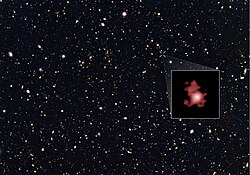Planetary system
The star has one known planet, Kepler-737b.
Kepler-737b [6] was confirmed on May 18, 2016 from data collected earlier by the Kepler space telescope, notable for orbiting in the habitable zone but not likely to be habitable because it is tidally locked. [7] [8] [9] It may, however, have atmospheric circulation that would distribute the heat around the planet, potentially making a large portion of it habitable, although given its stellar flux the most likely scenario is that the planet's surface is too hot to be habitable. Water on its surface could also distribute heat.
On the note of the Exoplanet Archive, Kepler-737b was dedicated that orbital period, transit mid-point, transit duration, Rp/Rs, and their errors are taken from DR24 KOI table. [5]
This page is based on this
Wikipedia article Text is available under the
CC BY-SA 4.0 license; additional terms may apply.
Images, videos and audio are available under their respective licenses.


